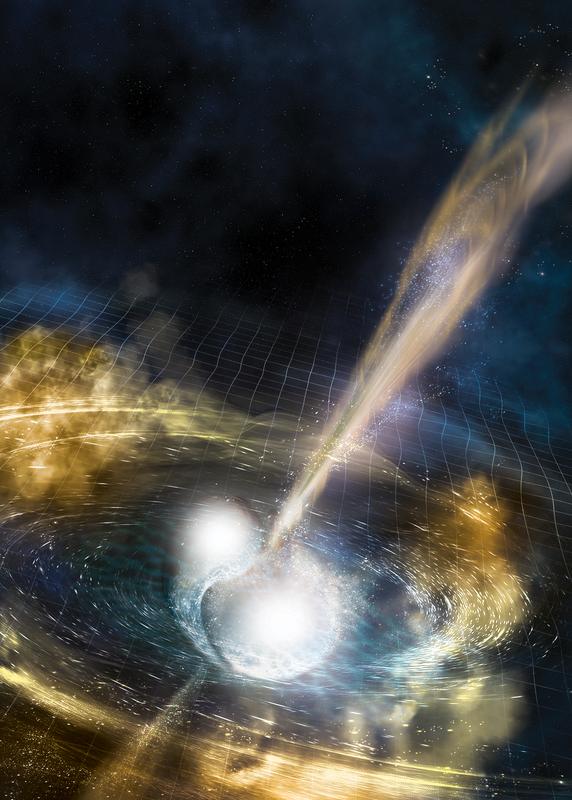HADES experiment simulates colliding and merging neutron stars Temperatures of 800 billion degrees in the cosmic kitchen

Illustration of two merging neutron stars. Gravitational waves travel out from the collision, seconds later a burst of gamma rays is shot out. The merging stars eject swirling clouds of material. Image: National Science Foundation/LIGO/Sonoma State University / A. Simonnet
When two neutron stars collide, the matter at their core enters extreme states. An international research team has now studied the properties of matter compressed in such collisions.
The HADES long-term experiment, involving more than 110 scientists, has been investigating forms of cosmic matter since 1994.
With the investigation of electromagnetic radiation arising when stars collide, the team has now focused attention on the hot, dense interaction zone between two merging neutron stars.
Simulation of electromagnetic radiation
Collisions between stars cannot be directly observed – not least of all because of their extreme rarity. According to estimates, none has ever happened in our galaxy, the Milky Way. The densities and temperatures in merging processes of neutron stars are similar to those occurring in heavy ion collisions, however.
This enabled the HADES team to simulate the conditions in merging stars at the microscopic level in the heavy ion accelerator at the Helmholtzzentrum für Schwerionenforschung (GSI) in Darmstadt.
As in a neutron star collision, when two heavy ions are slammed together at close to the speed of light, electromagnetic radiation is produced. It takes the form of virtual photons that turn back into real particles after a very short time. However, the virtual photons occur very rarely in experiments using heavy ions.
“We had to record and analyze about 3 billion collisions to finally reconstruct 20,000 measurable virtual photons,” says Dr. Jürgen Friese, the former spokesman of the HADES collaboration and researcher at Laura Fabbietti’s Professorship on Dense and Strange Hadronic Matter at TUM.
Photon camera shows collision zone
To detect the rare and transient virtual photons, researchers at TUM developed a special 1.5 square meter digital camera. This instrument records the Cherenkov effect: the name given to certain light patterns generated by decay products of the virtual photons.
“Unfortunately the light emitted by the virtual photons is extremely weak. So the trick in our experiment was to find the light patterns,” says Friese.
“They could never be seen with the naked eye. We therefore developed a pattern recognition technique in which a 30,000 pixel photo is rastered in a few microseconds using electronic masks. That method is complemented with neural networks and artificial intelligence.”
Observing the material properties in the laboratory
The reconstruction of thermal radiation from compressed matter is a milestone in the understanding of cosmic forms of matter. It enabled the scientists to place the temperature of the new system resulting from the merger of stars at 800 billion degrees celsius. As a result, the HADES team was able to show that the merging processes under consideration are in fact the cosmic kitchens for the fusion of heavy nucleii.
Further information:
The HADES project is making it possible to collect data on strange particles believed to exist only in the core of neutron stars. With their study of strangeness in particles, Prof. Fabbietti's team is helping to lay the foundation for realistic models of neutron stars.
Prof. Dr. Laura Fabbietti
Technical University of Munich
Professor for Dense and Strange Hadronic Matter
Tel.: +49 (0) 89 289-12433
laura.fabbietti@ph.tum.de
Dr. Jürgen Friese
Technical University of Munich
Professor for Dense and Strange Hadronic Matter
Tel.: +49 (0) 89 289-12441
juergen.friese@ph.tum.de
The HADES-Collaboration: Probing dense baryon-rich matter with virtual photons. In: Nature Physics (published on July 29, 2019).
DOI: 10.1038/s41567-019-0583-8
https://doi.org/10.1038/s41567-019-0583-8
https://www.tum.de/nc/en/about-tum/news/press-releases/details/35655/ Link to the press release
Media Contact
All latest news from the category: Physics and Astronomy
This area deals with the fundamental laws and building blocks of nature and how they interact, the properties and the behavior of matter, and research into space and time and their structures.
innovations-report provides in-depth reports and articles on subjects such as astrophysics, laser technologies, nuclear, quantum, particle and solid-state physics, nanotechnologies, planetary research and findings (Mars, Venus) and developments related to the Hubble Telescope.
Newest articles

“Nanostitches” enable lighter and tougher composite materials
In research that may lead to next-generation airplanes and spacecraft, MIT engineers used carbon nanotubes to prevent cracking in multilayered composites. To save on fuel and reduce aircraft emissions, engineers…

Trash to treasure
Researchers turn metal waste into catalyst for hydrogen. Scientists have found a way to transform metal waste into a highly efficient catalyst to make hydrogen from water, a discovery that…

Real-time detection of infectious disease viruses
… by searching for molecular fingerprinting. A research team consisting of Professor Kyoung-Duck Park and Taeyoung Moon and Huitae Joo, PhD candidates, from the Department of Physics at Pohang University…





















